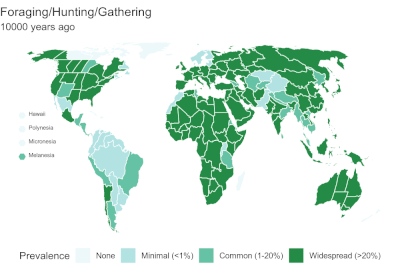Band society
| Part of a series on |
| Political and legal anthropology |
|---|
| Social and cultural anthropology |


A band society, sometimes called a camp, or in older usage, a horde, is the simplest form of human
Origins of usage in anthropology
'Band' was one of a set of three terms employed by early modern ethnography to analyse aspects of
In 1936, Julian Steward reformulated Radcliffe Brown's highly restrictive definition, by proposing the idea of a band society at the hunter-gatherer level which could be patrilineal, matrilineal or a composite of both.[7] Over time, 'band' has tended to replace the earlier word 'horde' as more extensive comparative work on hunter-gatherer societies shows they are not classifiable as simply closed patrilineal groups, and better approached in terms of a notion of a flexible, non-exclusive social band, having bilateral relations for marriage and other purposes with similar groups in a circumscribed territory.[8]
In 1962,
The word "band" is also used in North America, for example among the indigenous peoples of the Great Basin. With African hunter-gatherers, for instance among the Hadza, the term "camp" tends to be used.[10]
Characteristics
Bands have a loose organization. They can split up (in spring/summer) or group (in winter camps), as the
Definitions and distinctions
- It denotes people who customarily share the same camp and lifestyle.
- It is the primary landowner of a given territory.
- Each horde was independent and autonomous, regulating its social life by a camp-council, generally under the direction of a headman.
- Children pertained to the father's horde
- A unified horde identity was affirmed in all relations with external tribes.[13]
In his 1975 study, The Notion of the Tribe, Morton Fried defined bands as small, mobile, and fluid social formations with weak leadership that do not generate surpluses, pay taxes or support a standing army.[14]
Bands are distinguished from
Examples
Band societies historically were found throughout the world, in a variety of climates, but generally, as civilisations arose, were restricted to sparsely populated areas,
.See also
- Chiefdom, hierarchical political organizations in non-industrial societies.
- Tribe, a term with various meanings, including a band, a collection of related bands, or a more hierarchical chiefdom.
- Lineage-bonded societies, acephalous societies predicated on claims of a common ancestor.
- Band governments, in Canada, the basic unit of government for those peoples subject to the Indian Act
Notes
Citations
- ^ Zatrev 2014, p. 260.
- ^ Helm 2000, p. 2.
- ^ Radcliffe-Brown 1918, p. 222.
- ^ Yule & Burnell 2013, pp. 382–383.
- ^ Helm 2000, pp. 3–4.
- ^ Denham 2014, pp. 115–116.
- ^ Kelly 2013, pp. 7–8.
- ^ Kelly 2013, pp. 2ff..
- ^ Peterson 2006, p. 16.
- ISBN 978-0-520-25342-1.
- ^ Briggs 1982, p. 111.
- ^ a b Erdal et al. 1994, pp. 176–177.
- ^ Radcliffe-Brown 1918, pp. 222–223.
- ^ Fried 1975, pp. 8–9.
- ^ Schapera 1963, p. 23.
- ^ Berdichewsky 1979, p. 5.
Sources
- Berdichewsky, Bernardo (1979). "Anthropology and the Peasant Mode of Production". In Berdichewsky, Bernardo (ed.). Anthropology and Social Change in Rural Areas. ISBN 978-3-110-80773-8.
- Briggs, Jean L. (1982). "Living Dangerously:The contradictory foundations of value in Canadian Inuit society". In Leacock, Eleanor; Lee, Richard B. (eds.). Politics and History in Band Societies. ISBN 978-0-521-28412-7.
- Denham, Woodrow W. (May 2014). "Residential Group Compositions among the Alyawarra". Mathematical Anthropology and Cultural Theory. 6 (1): 1–132.
- Erdal, David; Whiten, Andrew; Boehm, Christopher; Knauft, Bruce (April 1994). "On Human Egalitarianism: An Evolutionary Product of Machiavellian Status Escalation?" (PDF). S2CID 53652577.
- Fried, Morton Herbert (1975). The Notion of Tribe. Cummings Pub. Co. ISBN 978-0-846-51548-7.
- ISBN 978-0-877-45735-0.
- ISBN 978-1-107-02487-8.
- Peterson, Nicolas (March 2006). "'I Can't Follow You on This Horde-Clan Business at All': Donald Thomson, Radcliffe-Brown and a Final Note on the Horde". JSTOR 40332006.
- JSTOR 2843422.
- Schapera, I (1963). "The Native Inhabitants". In Walker, Eric Anderson (ed.). The Cambridge History of the British Empire: South Africa, Rhodesia, and the High Commission territories. Vol. 8. Cambridge University Press. pp. 21–49.
- ISBN 978-0-199-60113-4.
- Zatrev, Jordan (2014). "The co-evolation of human intersubjectivity, morality, and language". In Dor, Daniel; Knight, Chris; Lewis, Jerome (eds.). The Social Origins of Language. ISBN 978-0-191-64312-5.
